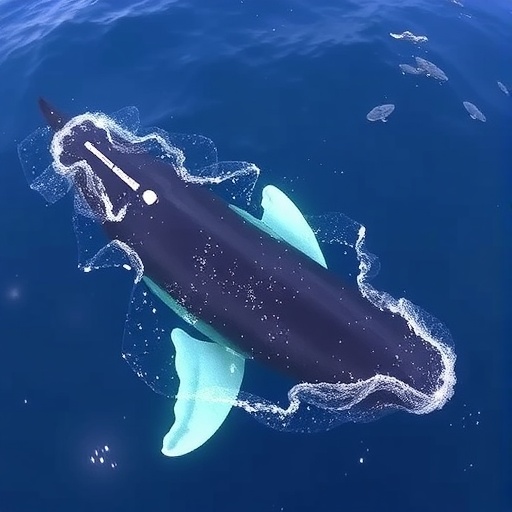In a groundbreaking marine biology expedition conducted in the culturally significant waters of Quandamooka Sea Country within Moreton Bay, Queensland, Australia, a team of multidisciplinary researchers from Griffith University has successfully recorded the first known underwater video footage of humpback whale calves nursing. This remarkable achievement provides unprecedented insight into the social and biological behaviors of these magnificent marine mammals, cementing Moreton Bay’s importance as a critical nursery and resting area during humpback whale migratory cycles.
The research utilized innovative suction-cup camera tags equipped with integrated video recording, acoustic sensors, and fine-scale movement tracking technology, enabling continuous, close-up observation of mother-calf pairs in their natural environment without intrusive interference. This methodological breakthrough has yielded compelling evidence of frequent nursing bouts—an essential behavior for calf growth and survival—documented in approximately half of the calves equipped with these camera tags. The rich dataset offers a multidimensional perspective on calf development, maternal investment, and social interactions within this protected bay.
This pioneering study marks the inaugural deployment of camera-equipped suction-cup tags on humpback whale calves in Australian waters and is among the first globally to generate comprehensive datasets combining synchronized video, acoustic, and kinematic data for these young cetaceans. Research lead and PhD candidate Stephanie Stack emphasized how these integrative data streams enable scientists to capture subtle behaviors, vocalizations, and movement patterns that have long remained elusive in wild cetacean populations, illuminating key aspects of humpback developmental ecology.
Findings from this study contribute significantly to the broader ongoing ‘Life in the Shipping Lane’ project, an Australian Research Council Linkage initiative led by Professor Susan Bengston Nash. The project assesses the risks imposed by shipping traffic on humpbacks in Quandamooka Sea Country. Comprehensive long-term monitoring across the 2024 and 2025 migration seasons confirmed consistently high densities of mother-calf pairs utilizing Moreton Bay, underscoring the bay’s function as a vital calving ground and nursery habitat that supports critical early life stages of humpback whales.
Additional observations have expanded scientific understanding of humpback social structures within the bay. Notably, researchers documented not only typical mother-calf pairs but also the presence of lone adult whales and unprecedented group gatherings involving multiple mother-calf pairs socializing simultaneously—a complex social phenomenon previously undocumented in this locale. These behavioral insights advance knowledge regarding humpback sociality, communication, and potential cooperative behaviors within nursery habitats.
Over the course of the two field seasons, thirteen successful deployments of the suction-cup camera tags resulted in an extraordinary accumulation of over 35 hours of detailed video, acoustic recordings, and fine-scale movement data specifically focused on calf development and mother-calf interactions. This extensive dataset presents a valuable resource for marine biologists aiming to decode early humpback behavior patterns and the acoustic environment experienced by calves during a critical growth period.
Beyond biological insights, the study’s outcomes bear direct implications for environmental management and conservation policy. The importance of Moreton Bay as a safe haven for nursing calves and resting mothers calls for a reevaluation of human activities within the bay, particularly concerning the increasing recreational and commercial vessel traffic observed throughout the region. Researchers noted frequent interactions between vessels and resting whales, often occurring in shallow or surface waters, highlighting collision risks and potential disturbances that could negatively impact whale health and behavior.
The research team also documented multiple propeller strike scars on whales, providing tangible evidence of physical injuries linked to watercraft activity. Such findings underscore the urgent need for enhanced boat operator awareness, stricter regulations, and proactive measures during peak migration seasons to minimize harmful encounters. This aligns with global efforts to mitigate human-induced threats to vulnerable marine megafauna through science-based management strategies.
Collaborative efforts between Griffith University, the University of Hawaii, the Quandamooka Traditional Owners, and industry stakeholders including the Port of Brisbane and environmental organizations have been pivotal in facilitating this research. This interdisciplinary and cross-sector partnership framework ensures that both scientific rigor and indigenous ecological knowledge inform strategies for protecting humpback whale populations and safeguarding Moreton Bay’s ecological integrity.
Professor Bengston Nash emphasized that these findings should guide planned state government re-zoning initiatives in Moreton Bay, urging policymakers to adopt a holistic valuation of the bay’s ecological, social, and cultural significance. This approach prioritizes long-term conservation outcomes rather than short-term economic interests, preserving critical whale habitats for future generations amid growing development pressures.
In summary, this landmark study not only advances the scientific understanding of humpback whale calf behavior and mother-calf dynamics but also reinforces Moreton Bay’s status as an indispensable nursery and sanctuary within the global humpback migratory network. It invites a renewed commitment to responsible stewardship and informed marine spatial planning, ensuring that these iconic creatures continue to thrive in Australian waters.
Subject of Research: Humpback whale calf nursing behavior and habitat use in Moreton Bay, Australia
Article Title: Groundbreaking Underwater Video Captures Humpback Whale Calves Nursing in Moreton Bay
News Publication Date: Information not provided
Web References:
https://mediasvc.eurekalert.org/Api/v1/Multimedia/8a043df8-6836-4add-8c80-0db350569ed6/Rendition/low-res/Content/Public
Image Credits: Stephanie Stack
Keywords: Humpback whales, nursing behavior, Moreton Bay, marine biology, suction-cup camera tags, calf development, mother-calf pairs, marine conservation, underwater footage, acoustic data, fine-scale movement, shipping traffic impacts




